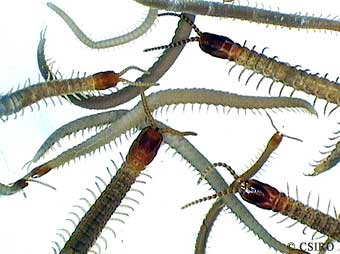Simple eyes
The last
pair of legs in many centipedes are often strong and brightly
coloured and although look quite dangerous and venomous are
only used to grasp prey or wave in a defensive display. The
bite of centipedes may be painful to humans but is not deadly
and usually only results in localised swelling and irritation.
Scolopendrid
centipedes like the one pictured above are robust species ranging
from 5-10 centimetres in length. Most have between 21 and 23
pairs of legs with the last pair usually longer and thicker
and used for grasping prey. These grasping legs are often a
bright red colour and are sometimes thought to be 'poison jaws'
but are totally harmless. Scolopendrid species are more common
in the drier areas of the country and can often be found under
rocks and logs or under the bark of trees.
Life
Cycle
Male
centipedes usually spin a small web onto which they deposit
a sperm packet for the female to pick up. In some species there
may be a short courtship dance or tapping of antennae before
the female is encouraged to take the sperm packet into her genital
opening. Eggs may be laid in groups or singularly under a rock
or log, in the soil or under bark and may or may not be guarded
by the female depending on the species. Some species on hatching
look exactly like their parents and have the full complement
of legs and body segments. Other species have less legs and
body segments than their parents and will gain more with successive
moults.
Centipedes will moult
several times before reaching sexual maturity.
Feeding
Centipedes
are predatory and will kill and consume a variety of other invertebrates
such as spiders, molluscs, many insects, slaters and other centipedes.
Some have been observed feeding on small vertebrates such as
frogs, mice and small geckoes. Prey is usually immobilised by
venom injected through the fangs and then torn into pieces by
the mandibles and the soft parts are eaten.
|

Geophilida (earth centipedes)
|
Habitat
Centipedes
are found in a variety of habitats in Australia depending on
the species, ranging from moist rainforests to the drier regions
of Australia. Centipedes can usually be found living under rocks,
logs or the bark of trees or in soil or leaf litter. Many species
are common around human dwellings and are often seen in compost
heaps or other garden refuse, while some may even venture into
houses.
Earth centipedes are very long and slender and usually found
in moist habitats such as under rocks and logs or in leaf litter.
Most species
are blind and can be distinguished from other centipedes as
they have more than 31 pairs of legs.
They have
rectangular shaped heads and relatively short legs which enable
them to move with ease through the leaf litter and soil of their
environment.